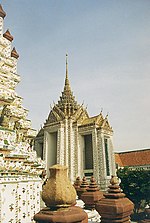Mondop

As Mondop (from Sanskrit Mandapa - "Pavilion") is called a cube-shaped building in a Wat , the Buddhist temple in Thailand .
Origin and architecture
The term is derived from Mandapa , the pillared vestibule or assembly hall of the Indian temple , which is in front of the cult area of the deity (Sanskrit Garbhagriha ).
In Thailand it means a building with a square floor plan, which can appear enlarged on all four sides by surrounding rows of columns or by portico . The roof is usually made of wood, it can be staggered several times. It is then topped with a slender tip.
use
Such a building can be used to accommodate particularly sacred objects (see Buddha's footprint in Wat Phra Phutthabat near Saraburi , picture above), or it can be used, for example, to hold the urn of Supreme Patriarch Prince Paramanuchit Chinnorot after his death in the Wat Pho on a so-called Busabok platform.
Other examples: the huge seated Buddha at Wat Si Chum (see picture center) and the large standing Attharot -Buddhas in Wat Mahathat ( "Temple of the Great Relic", both in Sukhothai Historical Park ) are also located in Mondops whose roofs over Time have passed. Very beautiful, elegant Mondops in the Burmese style are in Lampang in Wat Pong Sanuk Thai or in Wat Phra Kaeo Don Tao .
Another possible use for a Mondop is the library ( Hor Trai ) in a Wat , for example in Wat Phra Kaeo in Bangkok or the Phra Mondop in Wat Pho , also in Bangkok.
literature
- KI Matics: Introduction to the Thai Temple . White Lotus, Bangkok 1992, ISBN 974-8495-42-6

